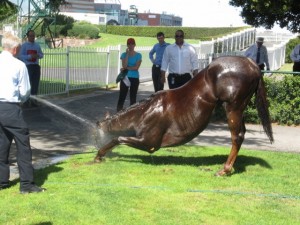A hot day with a forecast top of 37 degrees and a gale force northerly wind. There’s hardly a horse to be seen out the back as they are allowed to arrive on course much later on these hot days. And the sprinklers are running on top of the stalls, which is a good idea. And the horses spend more time in the parade ring, which is shaded, and then go up to the mounting yard at the last minute. Front running horses were clearly disadvantaged battling into the hot wind and in every race they knocked up to be run over by the swoopers. In the sixth race The Soldier led to the turn but gave up the battle to finish tailed off 50 lengths last. The stewards report noted that “The Soldier compounded in the straight. A subsequent veterinary examination revealed the gelding to be suffering from extreme heat stress.”
Out the back in the parade ring The Soldier had a real fight on his hands. He was on his knees being hosed and then would get cranky and rear and buck and flail around helplessly. He finally collapsed onto the ground and a bucket brigade was organised to cool him down. He eventually made a full recovery. The stewards didn’t like me taking photographs, but it is a fact of life with racing in the heat that horses are going to get stressed. I suppose they are worried that it will cast racing in a poor light.
I checked my racebook notes and found that I had marked the horse as sweating up and quivering in the mounting yard before the race, something that I would rarely ever see. My feeling is the horse may have had an elevated temperature before it even raced.




Surely if the horse was quivering (not merely the usual muscle spasms one sees), the connections had a duty to request a vet check. The quivering may have been related to him already being heat-stressed (as you suggest), or perhaps he was exhibiting fear because he knew he would have to run in the heat. Either way, if it was visible to observers, the horse at least deserved to be vetted prior to running. If he had collapsed and died, it would have been viewed as just another “unfortunate tragedy”.
Under the Prevention of Cruelty to Animals Act 1979 (New South Wales) it is against the law to unreasonably, unnecessarily or unjustifiably expose an animal to excessive heat. When the horse races its body’s temperature increases. The fact that racehorses are forced to race on a hot day is at the very least abusing these animals and putting them at risk of collapsing and dying. And racehorses have died collapsing from heat stress. The racing industry doesn’t give a damn about these animals.